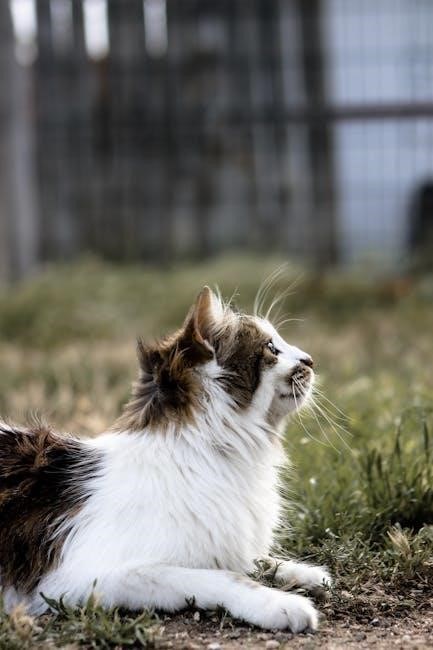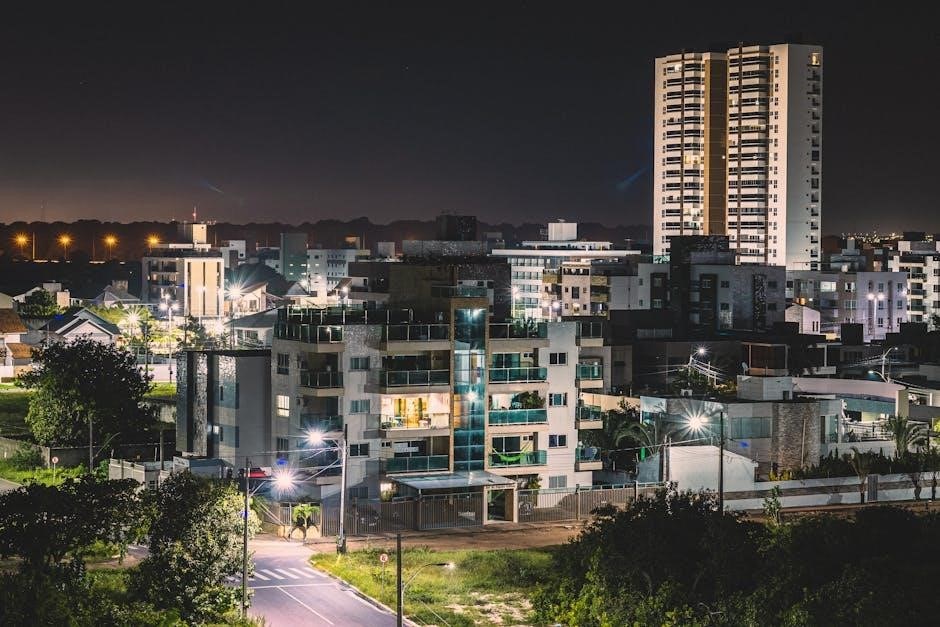The Canon EOS Rebel XT‚ also known as the EOS 350D‚ is a compact and lightweight entry-level DSLR camera designed for photography enthusiasts and professionals․
Released in 2005‚ it became a breakthrough in the digital SLR market‚ offering an 8․0-megapixel CMOS sensor and compatibility with Canon’s EF lens mount system․
Known for its user-friendly interface and versatile shooting modes‚ the Rebel XT is ideal for capturing high-quality images in various settings‚ from portraits to landscapes․
Its popularity stems from its affordability‚ portability‚ and advanced features‚ making it a favorite among both beginners and experienced photographers looking for a reliable camera․
The Rebel XT is part of Canon’s legacy of innovation‚ delivering exceptional image quality and performance‚ while remaining accessible to a wide range of users․
1․1 Overview of the Camera
The Canon EOS Rebel XT‚ known as the EOS 350D in Europe‚ is a lightweight and compact DSLR camera designed for photography enthusiasts; It features an 8․0-megapixel CMOS sensor and the DIGIC II image processor‚ ensuring high-quality images with vibrant colors․ The camera supports the EF lens mount system‚ offering compatibility with a wide range of lenses․ It includes a 2․4-inch LCD monitor for image preview and review․ The Rebel XT operates on a BP-511A battery‚ providing up to 400 shots per charge‚ and supports CF/MD memory cards for storage․ Its ergonomic design and intuitive controls make it accessible to both beginners and professionals‚ while its robust feature set appeals to photographers seeking creative control․ The Rebel XT is part of Canon’s legacy of delivering affordable‚ high-performance cameras that cater to a wide range of photography needs․
1․2 Key Features and Specifications
The Canon EOS Rebel XT features an 8․0-megapixel CMOS sensor and the DIGIC II image processor‚ delivering sharp and vibrant images․ It supports a range of shooting modes‚ including fully automatic‚ aperture priority‚ shutter priority‚ and manual․ The camera offers an ISO range of 100-1600‚ ensuring versatility in various lighting conditions․ It also features a fast autofocus system with seven selectable AF points‚ providing precise focus control․ The Rebel XT includes a built-in flash and compatibility with external flash units for enhanced lighting options․ Its 2․4-inch LCD monitor allows for easy image review‚ and the camera supports CF/MD memory cards for storage․ With a compact and lightweight design‚ the Rebel XT is both portable and user-friendly‚ making it an excellent choice for photographers of all skill levels․
1․3 Target Audience and Use Cases
The Canon EOS Rebel XT is designed for photography enthusiasts seeking a balance between performance and affordability․ It is ideal for beginners transitioning from point-and-shoot cameras to DSLRs‚ offering intuitive controls and manual modes for learning․ Professionals may use it as a secondary camera for specific projects․ The camera excels in various scenarios‚ including portraits‚ landscapes‚ and street photography‚ due to its portability and versatility․ Its user-friendly interface makes it suitable for hobbyists and casual shooters capturing family events or travel memories‚ while also serving as a reliable tool for educational photography workshops or classes․

Setting Up the Camera
Unbox and inspect the contents‚ including the camera body‚ battery‚ charger‚ and manual․ Charge the battery fully before first use and attach the lens carefully following the manual․
2․1 Unboxing and Package Contents
When unboxing the Canon EOS Rebel XT‚ you’ll find the camera body‚ a rechargeable lithium-ion battery‚ a battery charger‚ and a neck strap for easy carrying․
The package also includes an EF-S 18-55mm f/3․5-5․6 lens‚ a lens cap‚ and a user manual providing detailed instructions for setup and operation․
Additional items may vary‚ but the basic kit ensures you have everything needed to start shooting right away‚ with optional accessories available for enhanced functionality․
2․2 Initial Setup and Battery Charging
Begin by inserting the supplied battery into the charger and plug it into a power source․ Allow the battery to charge fully‚ which typically takes about 90 minutes․
Avoid overcharging‚ as it may reduce battery life․ Once charged‚ insert the battery into the camera‚ ensuring it is properly seated and the contacts align correctly․
Turn on the camera and navigate through the initial setup menu to set the date‚ time‚ and language․ This ensures your images are timestamped correctly and the camera functions optimally․
2․3 Lens Attachment and Basic Accessories
Attach the lens by aligning the EF-S or EF mount indexes on the lens and camera․ Gently twist until secure․ Ensure the lens is properly seated for optimal performance․
Use the provided camera strap for comfortable handling․ The lens cap protects the lens when not in use․ For storage‚ consider a protective case or pouch․
Basic accessories include a memory card and card reader for data transfer․ Optional items like tripods and external flashes enhance functionality and image quality․

Understanding the Camera Controls
The Canon EOS Rebel XT features an intuitive control layout‚ including a mode dial for selecting shooting modes and buttons for adjusting settings like ISO and autofocus․
3․1 External Controls and Button Layout
The Canon EOS Rebel XT features a user-friendly design with strategically placed external controls for easy access․ The mode dial on top allows quick selection of shooting modes‚ while the ISO button enables rapid adjustments․ The shutter release is ergonomically positioned for comfortable shooting․ The main dial controls aperture or shutter speed‚ depending on the mode․ Buttons for white balance‚ autofocus‚ and metering modes are conveniently located for intuitive operation․ The LCD screen provides a clear interface for navigating settings and reviewing images‚ making the camera highly accessible for both beginners and experienced photographers․
3․2 Mode Dial and Shooting Modes
The Canon EOS Rebel XT offers a variety of shooting modes via its mode dial‚ catering to different photography needs․ The fully automatic mode simplifies shooting for beginners‚ while aperture priority (Av) and shutter priority (Tv) modes provide control over specific settings․ The manual (M) mode allows advanced users to customize both aperture and shutter speed․ Additional modes include portrait‚ landscape‚ close-up‚ sports‚ and night scene‚ optimizing settings for specific genres․ This versatility makes the Rebel XT adaptable for various photographic scenarios‚ ensuring high-quality results across different conditions and user skill levels․
3․4 Customization Options for Controls
The Canon EOS Rebel XT offers custom functions that allow users to tailor camera settings to their preferences․ These functions‚ accessible via the menu‚ enable adjustments such as exposure compensation‚ autofocus behavior‚ and flash settings․ Additionally‚ the camera supports custom shooting modes (C1/C2) on the mode dial‚ letting users save and quickly access their favorite configurations․ While the Rebel XT lacks extensive button remapping‚ its custom functions and shooting modes provide ample flexibility for personalizing the camera to suit individual shooting styles and needs․ This feature enhances creativity and efficiency for photographers of all levels․

Shooting Modes Explained
The Canon EOS Rebel XT offers versatile shooting modes‚ including Fully Automatic‚ Aperture Priority‚ Shutter Priority‚ and Manual modes‚ catering to various photography scenarios and skill levels․
4․1 Fully Automatic Mode
In Fully Automatic Mode‚ the Canon EOS Rebel XT simplifies photography by controlling all settings‚ including aperture‚ shutter speed‚ ISO‚ and white balance‚ ensuring optimal results in various conditions․
This mode is ideal for beginners or quick snapshots‚ as it allows users to focus on composition without adjusting technical parameters‚ delivering high-quality images effortlessly in everyday situations․
4․2 Aperture Priority (Av) Mode
In Aperture Priority (Av) Mode‚ users set the desired aperture‚ and the camera automatically adjusts the shutter speed to ensure proper exposure․ This mode offers creative control over depth of field‚ allowing for blurred backgrounds or sharp landscapes‚ depending on the aperture selected․
Aperture Priority is ideal for photographers who want to prioritize depth of field without manually adjusting shutter speed‚ making it versatile for portraits‚ macro‚ and scenic photography while maintaining ease of use and high-quality results․
4․3 Shutter Priority (Tv) Mode
In Shutter Priority (Tv) Mode‚ photographers select a specific shutter speed‚ and the camera adjusts the aperture automatically to achieve optimal exposure․ This mode is perfect for capturing motion effects‚ such as freezing fast-moving subjects or creating artistic blur in waterfalls or sports photography․
By controlling shutter speed‚ users can convey dynamic movement or stability in their images‚ making Tv mode a versatile choice for various creative and practical shooting scenarios‚ enhancing control over image results effectively․
4․4 Manual (M) Mode
In Manual (M) Mode‚ photographers gain full control over both aperture and shutter speed‚ allowing precise adjustments to achieve desired creative effects․ This mode is ideal for experienced users who want absolute control over exposure settings․ By manually setting aperture and shutter speed‚ photographers can experiment with unique lighting conditions‚ artistic effects‚ or specific techniques like long exposures or shallow depth of field․ M Mode offers unparalleled flexibility‚ making it a powerful tool for mastering advanced photography techniques and understanding the fundamentals of exposure control effectively․

Image Quality and Settings
The Canon EOS Rebel XT features an 8․0-megapixel CMOS sensor‚ delivering high-resolution images with excellent detail and color accuracy․ The camera supports RAW file format for enhanced post-processing flexibility and offers various image quality settings to suit different shooting needs‚ ensuring optimal results in diverse photography conditions․
5․1 Sensor and Resolution Details
The Canon EOS Rebel XT is equipped with an 8․0-megapixel CMOS sensor‚ providing exceptional image quality with precise detail and vibrant colors․ The sensor captures images at a maximum resolution of 3456 x 2304 pixels‚ ensuring sharp and clear results even when enlarged․ This high-resolution capability makes the Rebel XT suitable for professional-grade photography‚ allowing users to crop images without compromising quality․ The sensor’s design also contributes to efficient light capture‚ enhancing overall performance in various lighting conditions․
5․2 ISO Range and Noise Performance
The Canon EOS Rebel XT features an ISO range of 100 to 1600‚ allowing flexibility in various lighting conditions․ At lower ISOs (100-400)‚ the camera delivers clean images with minimal noise․ As ISO increases‚ noise becomes more apparent‚ particularly in shadows‚ but remains manageable up to ISO 800․ At ISO 1600‚ noise is noticeable but still usable for small prints or web sharing․ The Rebel XT’s noise performance is respectable for its class‚ making it suitable for everyday photography‚ though best results are achieved at lower ISO settings․
5․3 White Balance and Color Accuracy
The Canon EOS Rebel XT offers multiple white balance settings‚ including Auto‚ Daylight‚ Shade‚ Tungsten‚ Fluorescent‚ and Custom‚ to ensure accurate color representation in various lighting conditions․ The camera excels in producing vibrant and natural colors‚ with reliable auto white balance performance․ For precise control‚ the Custom White Balance option allows users to set a specific color temperature․ The Rebel XT’s CMOS sensor and DIGIC II image processor work together to deliver consistent color accuracy‚ making it ideal for capturing lifelike hues in portraits‚ landscapes‚ and everyday photography․

Autofocus and Metering
The Canon EOS Rebel XT features a 7-point autofocus system for quick and precise subject tracking․ It supports multiple metering modes‚ including Evaluative‚ Center-Weighted‚ and Spot‚ ensuring accurate exposure control in various lighting conditions․
6․1 Autofocus Modes and Performance
The Canon EOS Rebel XT offers a robust autofocus system with 7-point wide-area AF‚ providing quick and accurate subject acquisition․ It supports multiple AF modes‚ including One-Shot AF for stationary subjects and AI Servo AF for tracking moving subjects․ The camera also features Predictive AF‚ which anticipates subject movement‚ ensuring sharp images even in dynamic situations․ Additionally‚ the AF system operates effectively in low-light conditions‚ making it versatile for various shooting environments․
6․2 Metering Modes (Evaluative‚ Center-Weighted‚ Spot)
The Canon EOS Rebel XT offers three metering modes: Evaluative‚ Center-Weighted‚ and Spot․ Evaluative metering analyzes the entire scene and adjusts exposure based on brightness‚ color‚ and subject distance․ Center-Weighted metering prioritizes the central area of the frame‚ ideal for portraits․ Spot metering measures light from a small‚ selectable area‚ useful for high-contrast scenes or backlit subjects․ These modes ensure accurate exposure control‚ catering to various lighting conditions and creative needs‚ providing photographers with flexibility and precision in capturing their vision․

Using the Built-In Flash
The Canon EOS Rebel XT features a built-in flash activated via the Flash button and Quick Control Dial․ It offers modes like Auto‚ Fill‚ and Red-Eye Reduction‚ providing versatile lighting solutions․ The flash can also sync with external units for enhanced illumination control․
7․1 Flash Modes and Settings
The Canon EOS Rebel XT’s built-in flash offers multiple modes to suit various lighting needs․ Auto mode activates the flash when additional light is required․ Fill mode ensures balanced lighting by illuminating shadows․ Red-Eye Reduction minimizes red-eye effects in portraits․ The flash intensity can be adjusted via the camera menu‚ providing flexibility for different scenes․ The Rebel XT uses the advanced E-TTL II metering system for accurate flash exposure‚ ensuring natural-looking results in both indoor and outdoor settings․ These settings make the built-in flash a versatile tool for enhancing image quality․
7․2 Syncing with External Flash Units
The Canon EOS Rebel XT supports external flash units via its hot shoe mount‚ enabling enhanced lighting control․ Users can synchronize external flashes with the camera’s E-TTL II system for precise exposure․ The flash mode can be set manually or automatically through the camera menu․ External flashes expand the camera’s lighting capabilities‚ offering more flexibility for professional and creative photography․ This feature allows photographers to achieve better results in challenging lighting conditions‚ making it ideal for studio or location shoots․ The Rebel XT’s compatibility with external flash units enhances its versatility for advanced lighting setups․
Software and Connectivity
The Canon EOS Rebel XT comes with EOS Utility software for remote shooting and image transfer․ It supports USB connectivity for seamless file transfer to computers․
8․1 EOS Utility Software Overview
The EOS Utility software is a versatile tool designed for Canon EOS cameras‚ including the Rebel XT․ It allows users to control the camera remotely‚ transfer images‚ and adjust settings directly from a computer․ This software is essential for streamlining workflows‚ especially for studio photography․ It also supports tethered shooting‚ enabling real-time preview and capture on a larger screen․ Additionally‚ EOS Utility provides firmware updates and enhances connectivity‚ making it an indispensable companion for photographers seeking advanced control and convenience․
8․2 Transferring Images to a Computer
Transferring images from the Canon EOS Rebel XT to a computer is straightforward using a USB cable or memory card reader․ Connect the camera directly via USB‚ or insert the memory card into a compatible reader․ The EOS Utility software can automatically detect and transfer images‚ while also allowing users to select specific files․ This method ensures efficient and organized image management․ For added convenience‚ users can also transfer images wirelessly using optional adapters‚ though USB remains the most reliable and common approach․

Customizing the Camera
Customize the Rebel XT with personal preferences using Custom Functions‚ which allow adjustments to exposure‚ focusing‚ and other settings for enhanced shooting efficiency and convenience․
9․1 Custom Functions and Settings
The Canon EOS Rebel XT offers customizable functions to tailor camera behavior to personal preferences․ Users can adjust settings like exposure compensation‚ autofocus modes‚ and metering types․ Custom Functions provide flexibility‚ allowing photographers to optimize the camera for specific shooting styles or conditions․ These settings are accessed via the menu system‚ ensuring easy customization without compromising performance․ This feature enhances user experience by streamlining workflows and adapting to individual needs‚ making the Rebel XT versatile for various photography scenarios․
9․2 Personalizing Shooting Preferences
The Canon EOS Rebel XT allows users to personalize shooting preferences for a tailored photography experience․ Photographers can adjust default settings‚ such as autofocus modes‚ white balance‚ and ISO sensitivity‚ to suit their creative vision․ Customizing these preferences enables consistent results across different shooting scenarios․ For example‚ portrait photographers might prioritize skin tones‚ while landscape shooters may opt for vivid colors․ These adjustments enhance workflow efficiency and ensure the camera aligns with individual artistic goals‚ making every shot reflect the photographer’s unique style and intent․

Maintenance and Troubleshooting
Regular maintenance ensures optimal performance and longevity of the Canon EOS Rebel XT․ This section covers essential cleaning routines and solutions for common issues․
10․1 Cleaning the Sensor and Lens
Regular cleaning of the sensor and lens is essential to maintain image quality and prevent dust or smudges from affecting your photos․ Use a soft‚ dry brush or blower to gently remove dust from the sensor․ For more stubborn particles‚ a microfiber cloth lightly dampened with water or a cleaning solution can be used‚ but avoid touching the sensor surface․ The lens should be cleaned with a microfiber cloth and a few drops of lens cleaning solution‚ avoiding harsh chemicals that could damage the coatings․ Always handle the camera with care to minimize contamination․
10․2 Common Issues and Solutions
Common issues with the Canon EOS Rebel XT include error messages like “Err 99” or “Card Error‚” often caused by faulty memory cards or lens communication problems․ To resolve “Err 99‚” try cleaning the lens contacts or resetting the camera․ For “Card Error‚” format the memory card in the camera or use a different card․ Battery drain can occur if the camera is not turned off properly or if using live view excessively; Ensure the lens is properly attached to avoid focus issues․ Refer to the manual for troubleshooting guides or reset the camera to factory settings if problems persist․

Accessories and Lenses
The Canon EOS Rebel XT supports EF-S and EF lenses‚ offering versatility for various photography needs․ Popular accessories include the EF-S 18-55mm kit lens‚ external flash units‚ and the EOS Utility software for enhanced functionality and image transfer․
11․1 Compatible EF-S and EF Lenses
The Canon EOS Rebel XT is compatible with a wide range of EF-S and EF lenses‚ offering flexibility for different photography styles․ The EF-S 18-55mm f/3․5-5․6 lens‚ often included as a kit lens‚ is ideal for everyday shooting‚ while the EF 50mm f/1․8 lens provides excellent portrait capabilities․ Additional options like telephoto and wide-angle lenses expand creative possibilities‚ ensuring high image quality and optical performance․ These lenses are designed to maximize the camera’s potential‚ catering to both beginners and advanced photographers seeking precision and versatility in their work․
11․2 Recommended Accessories for the Rebel XT
To enhance your photography experience with the Rebel XT‚ consider essential accessories․ A spare LP-E3 battery ensures extended shooting sessions‚ while high-capacity memory cards like CF/SD adapters store more images․ A tripod‚ such as the Canon EF Tripod Mount Ring‚ improves stability for low-light shots․ Additionally‚ a protective camera bag and lens cleaning kit maintain your equipment’s condition․ A remote shutter release prevents camera shake‚ and an external flash like the Speedlite 220EX adds lighting versatility․ These accessories help you get the most out of your Rebel XT․
The Canon EOS Rebel XT is a remarkable DSLR‚ balancing simplicity with advanced features‚ making it ideal for photographers of all skill levels․ Its legacy endures as a versatile and user-friendly camera‚ offering endless creative possibilities․ By following this guide‚ you can unlock its full potential and capture stunning images with ease․ Happy shooting!
12․1 Summary of Key Features
The Canon EOS Rebel XT boasts an 8․0-megapixel CMOS sensor‚ ensuring crisp and detailed images․ It features a wide range of shooting modes‚ including fully automatic‚ aperture priority‚ shutter priority‚ and manual‚ catering to both beginners and advanced photographers․ The camera supports Canon’s EF lens mount‚ offering compatibility with a vast array of lenses․ With its fast autofocus and flexible ISO range‚ the Rebel XT delivers excellent performance in various lighting conditions․ Additionally‚ it includes advanced metering modes and white balance options for precise control over image quality․ The EOS Utility software enhances workflow‚ making it a versatile tool for photography enthusiasts․
12․2 Final Tips for Getting the Most Out of the Rebel XT
To maximize your experience with the Rebel XT‚ experiment with its shooting modes to understand their strengths․ Regularly clean the sensor and lenses to maintain image clarity․ Utilize the EOS Utility software for efficient image transfer and editing․ Familiarize yourself with custom functions to tailor the camera to your preferences․ Practice white balance adjustments for accurate color representation․ Explore compatible EF lenses to expand your creative possibilities․ Finally‚ refer to the manual for troubleshooting common issues and optimizing performance in various shooting conditions․

Leave a Reply
You must be logged in to post a comment.